Hot Honey Garlic Beef Jerky
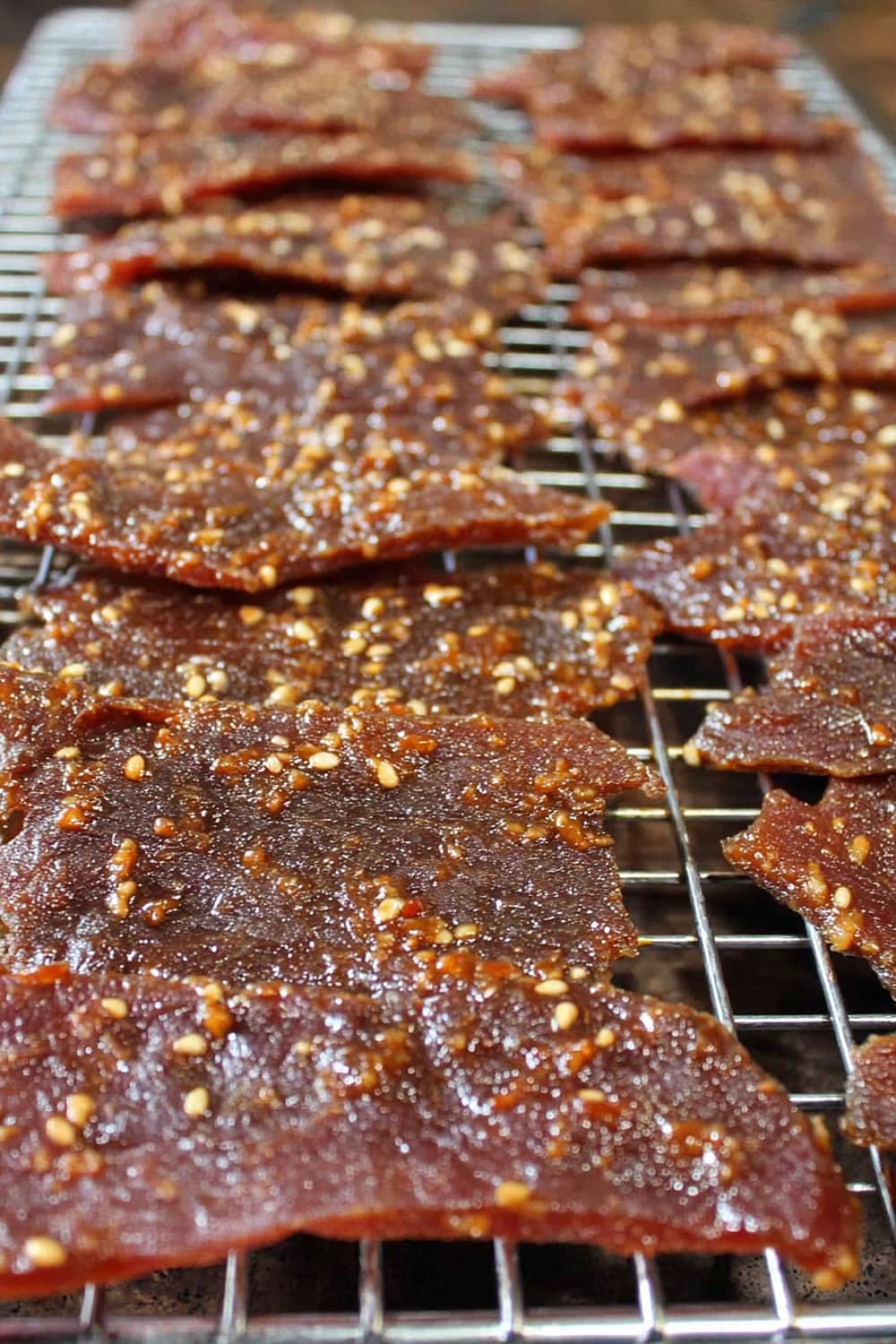
This isn’t your gas station jerky situation – we’re talking about homemade beef jerky that’ll make you question why you ever bought that overpriced, preservative-loaded stuff from the store.
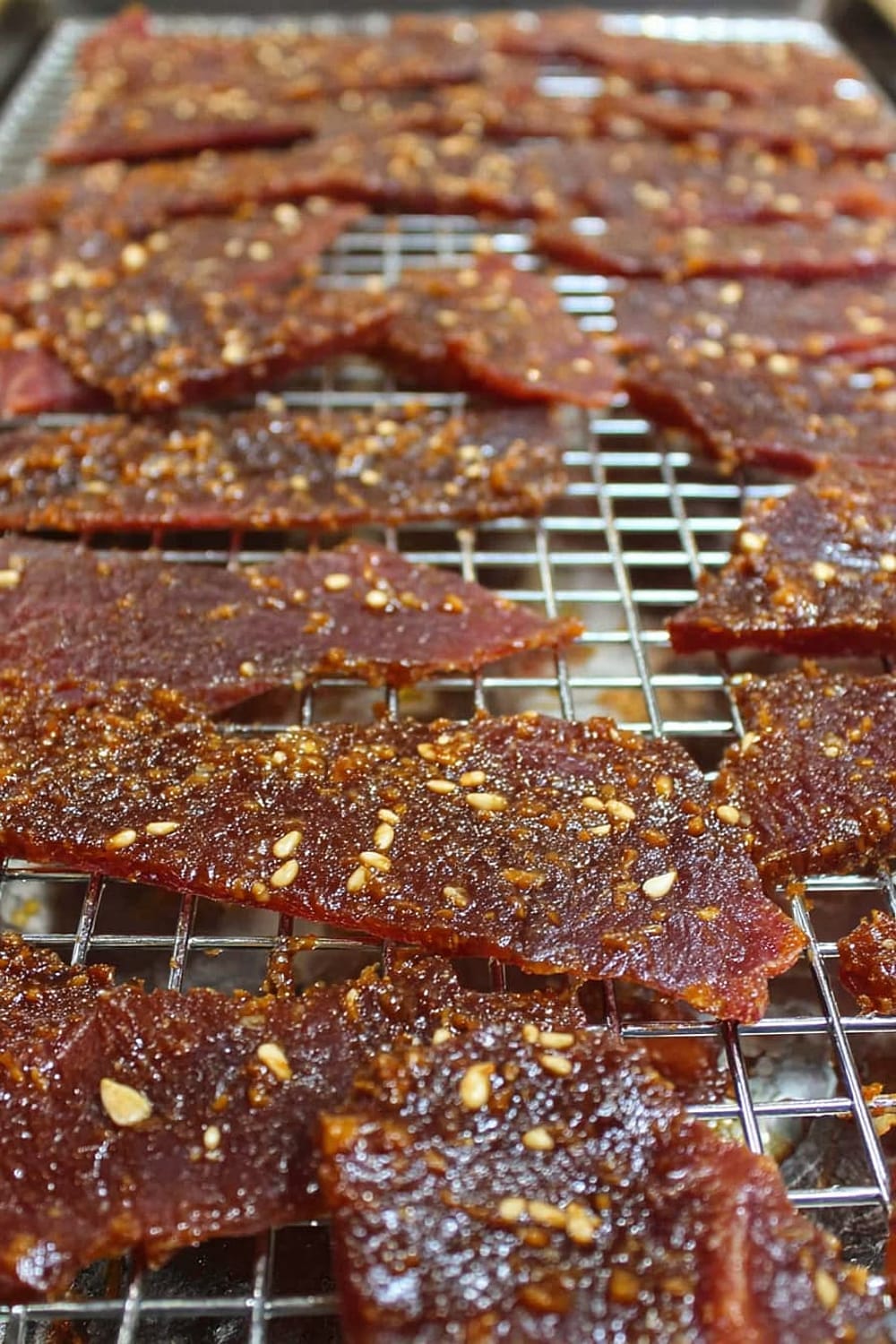
The combination of sweet honey, savory garlic, and that perfect kick of heat creates a flavor explosion that’s basically addictive in the best possible way.
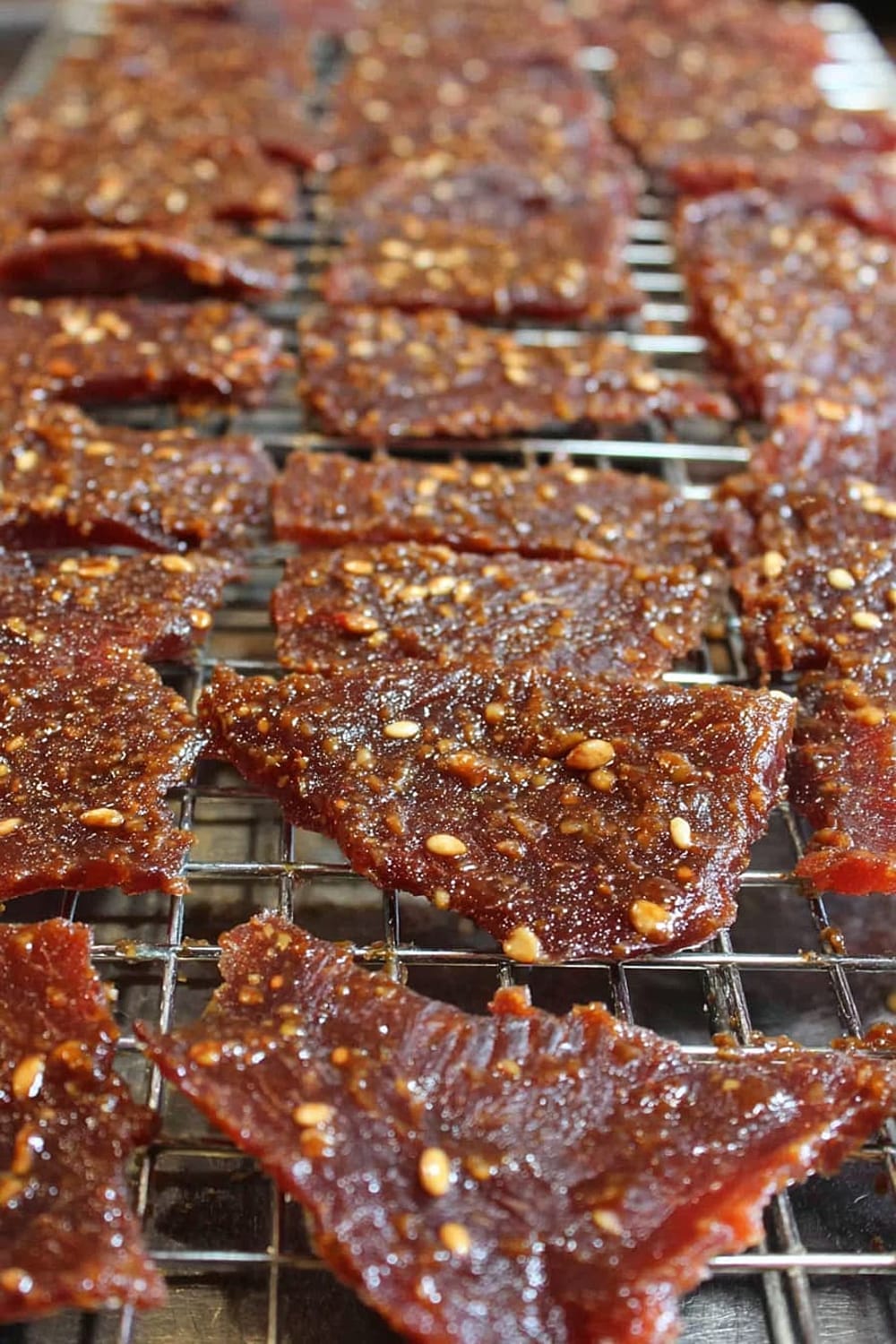
We’re using a cast iron skillet and proper smoking techniques to get that perfect chewy texture without turning your beef into leather boots.
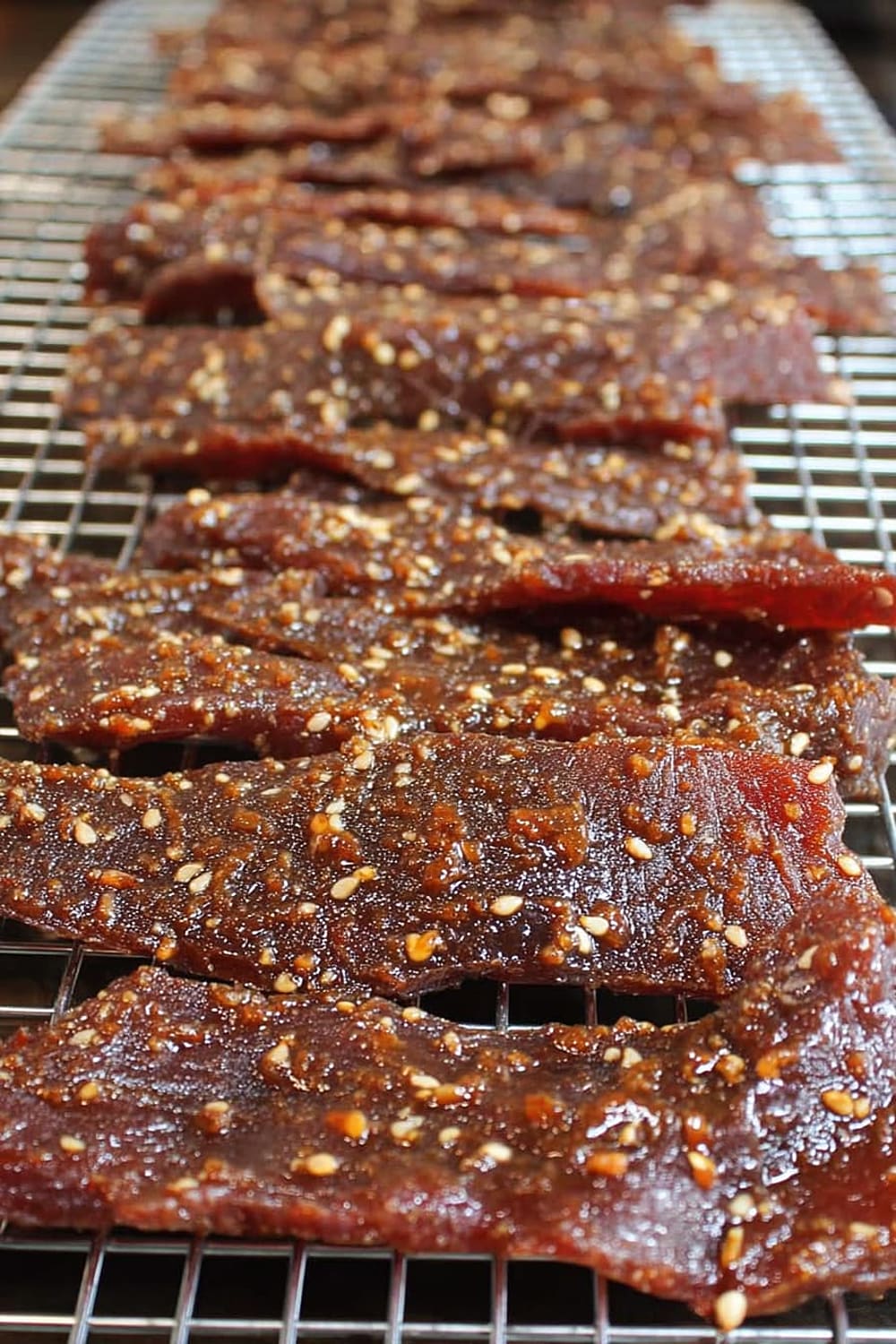
The secret weapon here is the black garlic sauce – it adds this incredible umami depth that elevates this jerky from good to “hide it from your family or it’ll disappear” level.
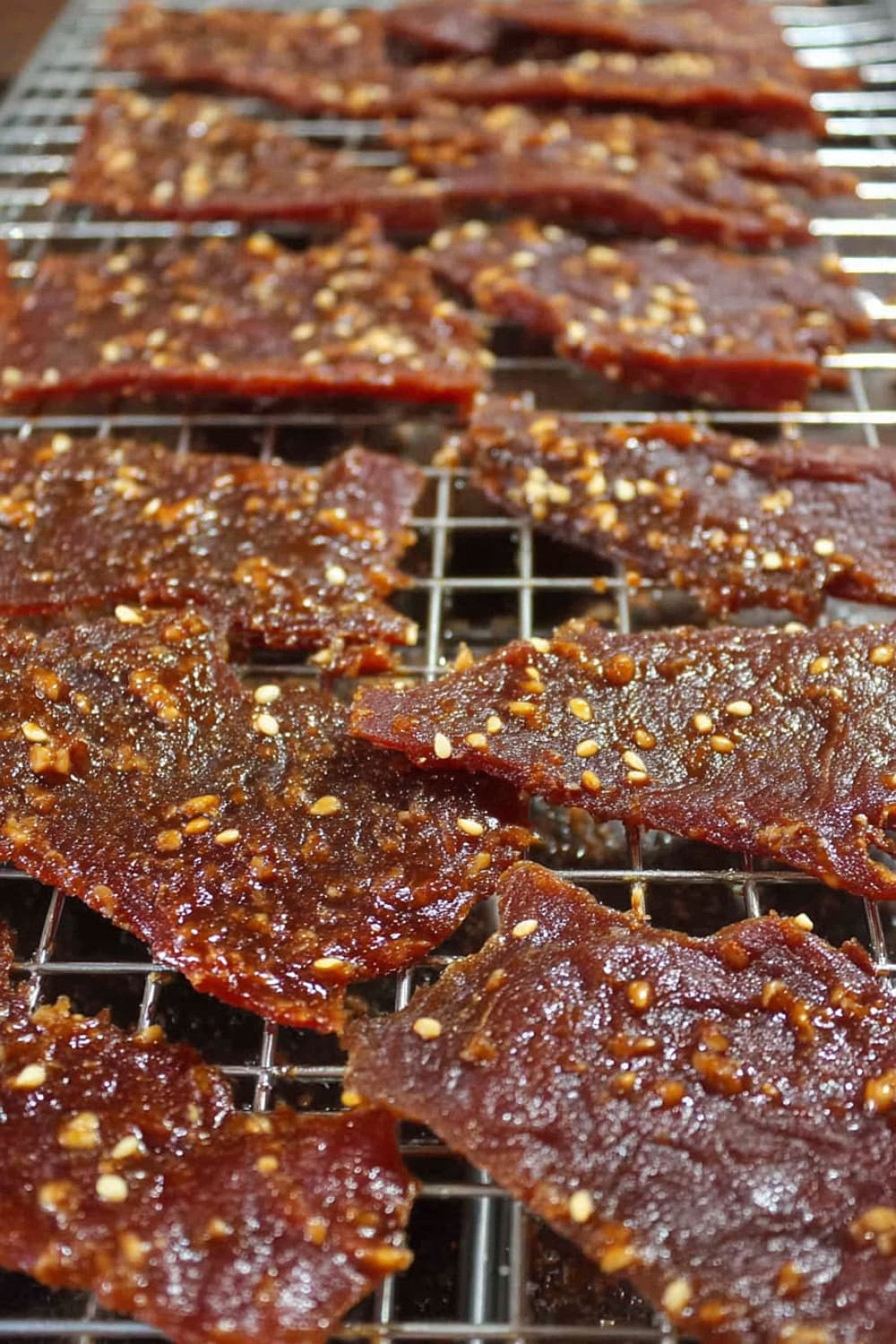
This recipe transforms a 3-pound beef round into premium snacking gold that costs a fraction of store-bought artisanal jerky.
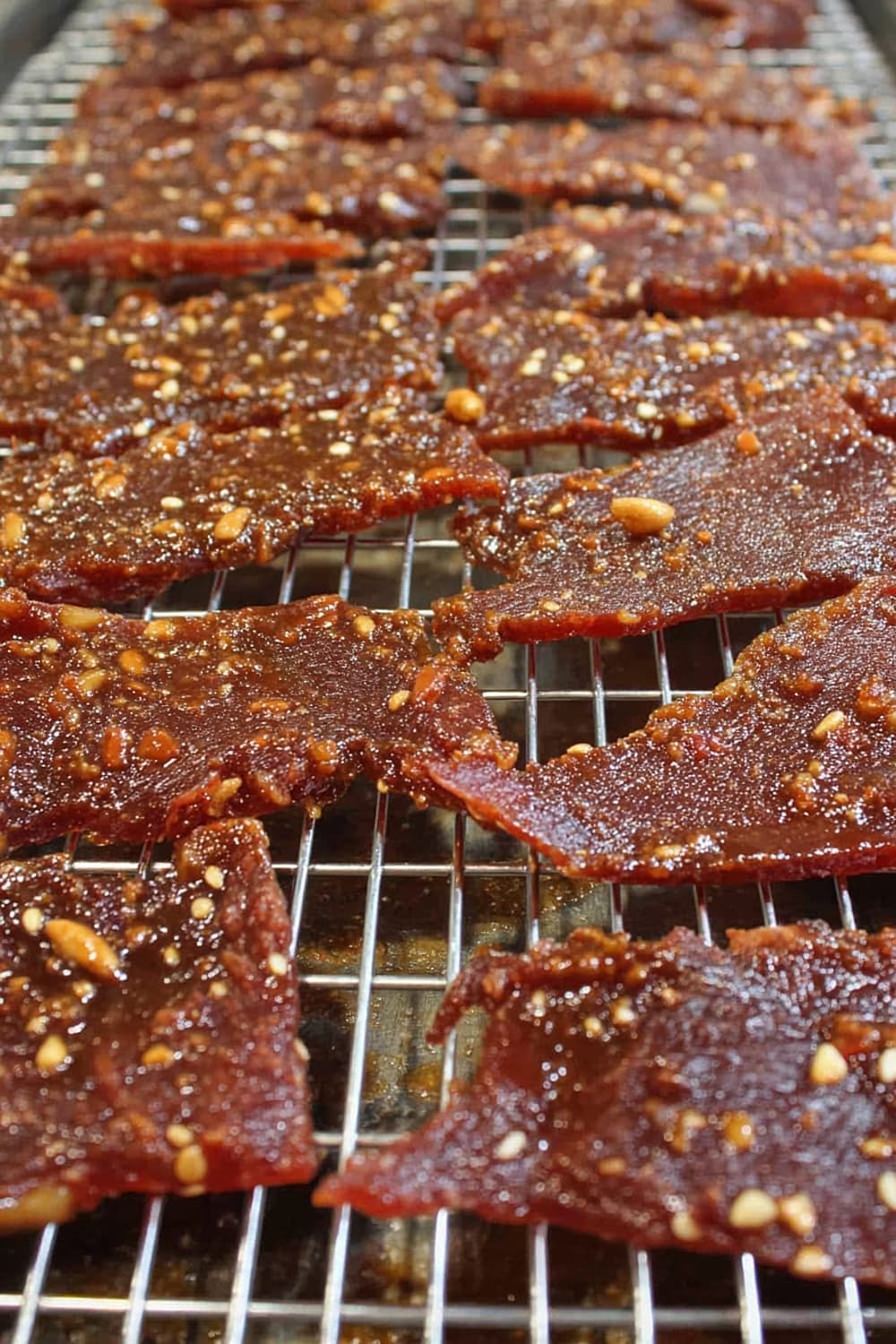
Fair warning: once you master this technique, you’ll become the person everyone hits up for homemade jerky, and honestly, that’s not a bad reputation to have.

Ingredients
Beef + Marinade
- 3 lbs beef round, trimmed of silver skin and fat
- 1 cup low-sodium soy sauce
- 2 tbsp minced garlic
- 1 .5 tbsp BLK hot sauce
- 1 .5 tbsp Big Bad BBQ ale rub
- 1 .5 tbsp brown sugar
- 1 .25 tbsp honey (plus extra for glazing)
- 1 tbsp black garlic sauce
- 1 tsp sesame seeds
Instructions
Prepare the Marinade
- 1 In a large mixing bowl, combine the low-sodium soy sauce, minced garlic, BLK hot sauce, BBQ ale rub, brown sugar, 1.25 tbsp honey, black garlic sauce, and sesame seeds. Whisk thoroughly with a silicone spatula until the brown sugar completely dissolves and the mixture is well combined. The marinade should have a glossy, slightly thick consistency. Set aside while you prepare the beef.
Prepare the Beef
- 2 Using a sharp knife on a sturdy cutting board, slice the 3-pound beef round in half lengthwise, working with the grain initially to create more manageable pieces. This makes the final slicing much easier and more consistent.
- 3 Now working against the grain, thinly slice the beef into strips approximately 1/4-inch thick. Consistent thickness is crucial for even drying – use a kitchen scale to check that pieces are uniform if you want professional results.
- 4 Place each beef strip on your cutting board and use a meat mallet to gently flatten the pieces to about 1/8-inch thickness. This step is essential for proper marinade penetration and even drying. Work systematically to ensure all pieces are evenly flattened.
Marinate the Beef
- 5 Transfer all flattened beef pieces to a large food-safe bag or storage container. Pour the prepared marinade over the beef, ensuring every piece is thoroughly coated. Massage the marinade into the meat through the bag for 2-3 minutes to ensure complete coverage.
- 6 Seal the bag tightly, removing as much air as possible, or cover the container with aluminum foil. Refrigerate for a minimum of 4 hours, but for optimal flavor development, marinate overnight or up to 24 hours. The longer marination creates deeper flavor penetration.
Smoking Process
- 7 Preheat your Oklahoma Joe’s Judge Charcoal grill for indirect cooking at 175°F (79°C). This low temperature is crucial for proper dehydration without cooking the meat. Use an instant-read thermometer to verify the temperature is stable before proceeding.
- 8 Remove the marinated beef from the refrigerator and arrange pieces evenly on a mesh tray, ensuring no pieces overlap. Proper air circulation around each piece is essential for even drying. Pat any excess marinade from the surface with paper towels.
Final Smoking and Finishing
- 9 Place the mesh tray in the smoker and cook for 4-5 hours, checking every hour after the 3-hour mark. The jerky is done when pieces no longer bend when picked up – they should crack slightly but not break completely. Internal temperature should reach 160°F (71°C) for food safety.
- 10 About 10 minutes before the jerky is finished, brush each piece with additional honey using a silicone brush. This creates a beautiful glaze and adds extra sweetness to balance the savory elements.
- 11 Remove the jerky from the smoker once it passes the bend test and let cool on the mesh tray for 2-3 minutes. The pieces will firm up slightly as they cool, achieving the perfect chewy texture.
Recommended Equipment and Kitchen Tools
Recommended Tools (for best results)
- Sharp chef’s knife – Essential for achieving consistent, thin slices that dry evenly and create professional-looking jerky
- Meat mallet – Flattens the beef strips for better marinade penetration and more uniform drying throughout the smoking process
- Large mixing bowls – Stainless steel bowls work best for combining the marinade ingredients without reactive flavors
- Food-safe storage bags – Heavy-duty bags ensure proper marination without leaks and allow for easy massage distribution
Helpful Upgrades
- Digital kitchen scale – Helps ensure consistent 1/4-inch thickness for even drying and professional results
- Instant-read thermometer – Critical for maintaining the precise 175°F (79°C) smoking temperature and verifying food safety
- Mesh smoking trays – Allows optimal air circulation around each piece for even dehydration
- Silicone spatula and brush – Non-reactive tools perfect for mixing marinades and applying the final honey glaze
Nice-to-Have Options
- Mandoline slicer – Creates perfectly uniform beef strips, though a sharp knife works well with practice
- Vacuum sealer – Excellent for marinating and long-term storage of finished jerky
- Multiple cutting boards – Separate boards for raw meat prep and other ingredients prevent cross-contamination
Recipe Variations and Dietary Modifications
Gluten-Free Adaptation
- Replace the soy sauce with tamari or coconut aminos using the same 1-cup measurement
- Verify that your BBQ rub is certified gluten-free, as some commercial rubs contain wheat-based fillers
- The cooking time and temperature remain exactly the same with these substitutions
Lower Sodium Version
- Reduce soy sauce to 3/4 cup and add 2 tbsp rice vinegar for tang
- Increase the garlic to 3 tbsp and add 1 tsp smoked paprika for enhanced flavor depth
- The marinade time should be extended to overnight for proper flavor development
Spice Level Variations
- Mild version: Replace BLK hot sauce with 1 tbsp sweet chili sauce
- Extra hot: Add 1 tsp cayenne pepper and increase hot sauce to 2 tbsp
- Smoky heat: Substitute hot sauce with 1.5 tbsp chipotle peppers in adobo, finely minced
Alternative Protein Options
- Turkey breast: Use the same marinade with 2.5 lbs turkey breast, reduce smoking time to 3-4 hours
- Venison: Excellent lean option, follow the exact same process but check for doneness at 3.5 hours
- Salmon: Create fish jerky using 2 lbs salmon fillet, reduce smoking time to 2-3 hours
Nutritional Information and Health Benefits
Key Nutritional Highlights
This homemade jerky provides approximately 80-90 calories per 1-ounce serving, with 15-18 grams of high-quality protein and minimal carbohydrates. The lean beef round creates an excellent protein-to-calorie ratio, making this an ideal snack for active lifestyles. Each serving contains less than 3 grams of sugar from the honey and brown sugar, significantly lower than most commercial jerky options.
Health Benefits of Main Ingredients
The grass-fed beef provides complete amino acids, iron, zinc, and vitamin B12 essential for energy metabolism and muscle maintenance. Fresh garlic contributes allicin compounds with anti-inflammatory properties and cardiovascular benefits. The low-sodium soy sauce reduces unnecessary sodium intake while providing umami flavor depth. Sesame seeds add healthy fats, lignans, and mineral content including calcium and magnesium.
Dietary Considerations
This recipe naturally fits high-protein, low-carb, and keto dietary patterns. The jerky is gluten-free when using tamari instead of soy sauce. Each 1-ounce serving contains approximately 2-3 grams net carbs, making it suitable for most low-carb eating plans. The smoking process eliminates the need for artificial preservatives found in commercial jerky products.
Smart Swaps and Ingredient Substitutions
Common Substitutions:
- Soy sauce → Tamari (1:1 ratio) for gluten-free option, or coconut aminos (1:1 ratio) for soy-free
- Brown sugar → Coconut sugar (1:1 ratio) or maple syrup (1 tbsp) for refined sugar-free
- Honey → Agave nectar (1:1 ratio) or pure maple syrup (1:1 ratio) for vegan adaptation
- Black garlic sauce → Regular minced garlic (2 tsp) plus 1 tsp balsamic vinegar
Budget-Friendly Swaps:
- Beef round → Eye of round or bottom round cuts work equally well at lower cost
- Artisanal BBQ rub → Homemade blend of paprika, garlic powder, onion powder, and black pepper
- BLK hot sauce → Sriracha or any fermented hot sauce with similar heat level
Pantry Emergency Substitutions:
- Fresh garlic → Garlic powder (2 tsp) mixed with 1 tbsp water for paste consistency
- Sesame seeds → Poppy seeds or omit entirely without affecting the core flavor profile
- BBQ rub → 2 tsp smoked paprika plus 1 tsp each of garlic powder, onion powder, and chili powder
Pro Tips for Substitutions:
- When using liquid sweeteners instead of brown sugar, reduce the soy sauce by 2 tbsp to maintain proper consistency
- Storage containers work better than bags when using liquid substitutions to prevent leaking during marination
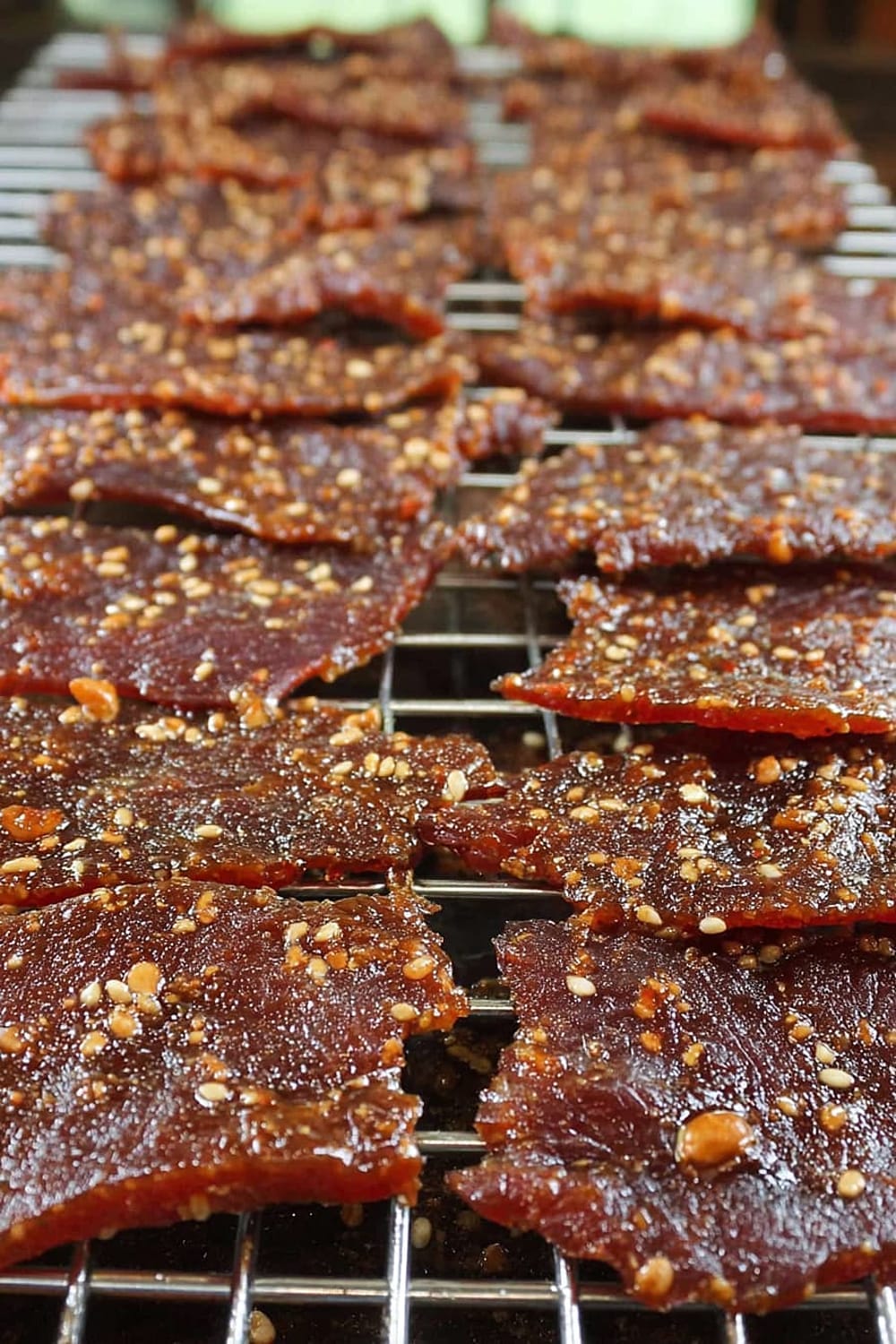
Make It Diabetes-Friendly
Sugar Substitutions:
- Replace brown sugar with sugar-free brown sugar substitute using 1 tbsp instead of 1.5 tbsp
- Substitute honey with sugar-free honey alternative or stevia-sweetened syrup using 1 tbsp total
- These modifications reduce carbs by approximately 12-15 grams per batch
Enhanced Protein Focus:
- Increase the beef portion to 3.5 lbs while keeping the same marinade ratios
- Add 1 tbsp chia seeds to the marinade for additional fiber and protein
- Consider using grass-fed organic beef for better nutrient density and omega-3 content
Portion & Timing Tips:
- Stick to 1-ounce servings (about 4-5 pieces) to maintain 2-3 grams net carbs per serving
- Pair with raw almonds or cheese cubes to create balanced blood sugar response
- Best consumed as mid-afternoon snack or post-workout when insulin sensitivity is higher
Total Carb Reduction:
Original recipe: ~6 grams carbs per serving
Modified version: ~2 grams carbs per serving
Net reduction: 65% fewer carbohydrates
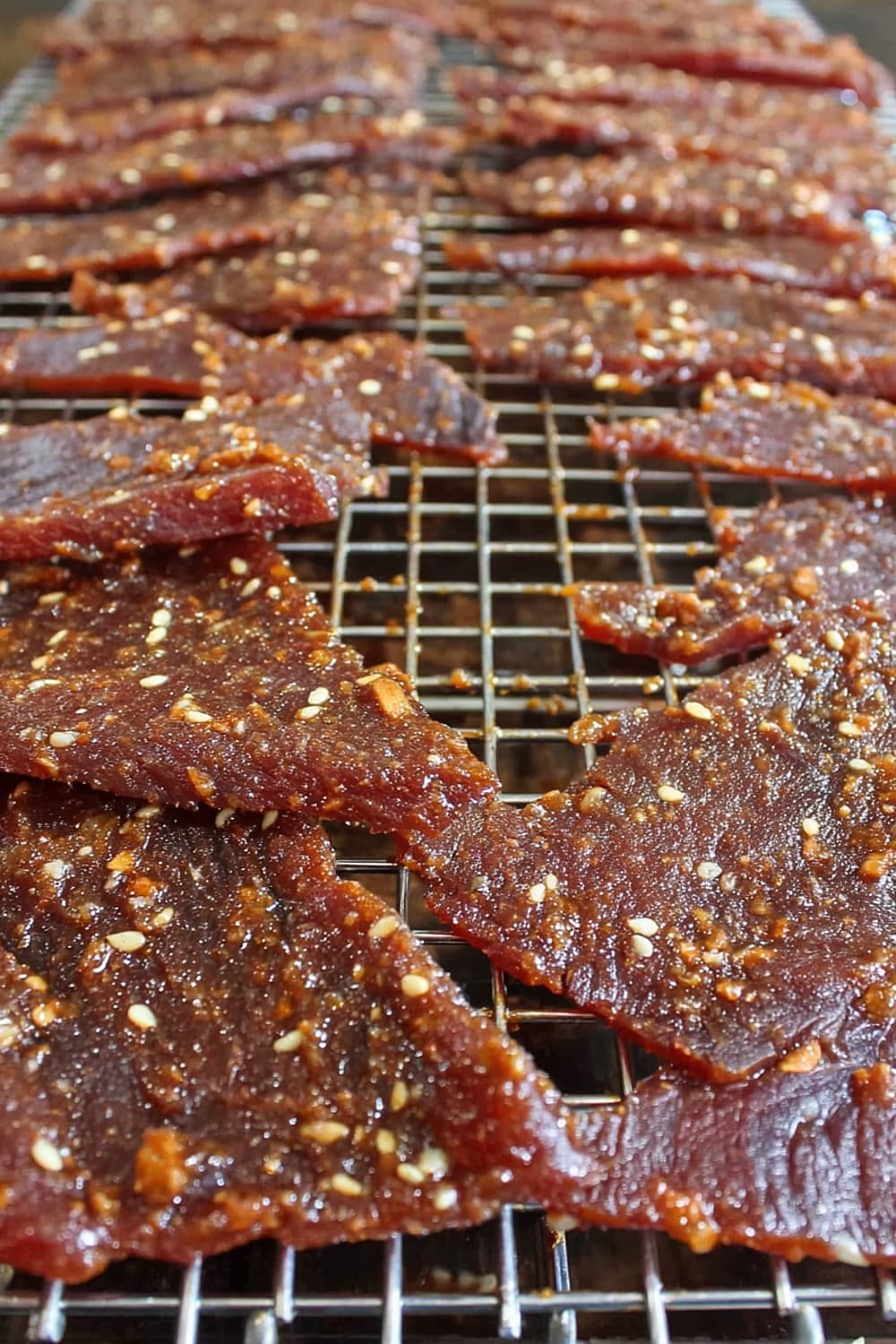
Perfect Pairing Suggestions
Beverage Pairings
The sweet-savory profile of this jerky pairs beautifully with craft beer, particularly amber ales or IPAs whose hoppy bitterness balances the honey sweetness. For wine enthusiasts, try Pinot Noir or Zinfandel – the fruit-forward characteristics complement the garlic and sesame flavors. Cold brew coffee makes an excellent non-alcoholic pairing, especially for afternoon snacking or outdoor adventures.
Complementary Snack Combinations
Create a premium snack board by pairing this jerky with aged cheddar, mixed nuts, and dried fruits. The protein-rich jerky balances perfectly with avocado slices and whole grain crackers for sustained energy. For entertaining, serve alongside hummus, olives, and fresh vegetables to create a sophisticated appetizer spread that accommodates various dietary preferences.
Complete Meal Ideas
This jerky works excellently as a salad topper, adding protein and flavor depth to mixed greens with Asian-inspired dressings. Chop it finely and incorporate into fried rice or grain bowls for added umami richness. For camping or hiking, pair with trail mix, energy bars, and fresh fruit for complete portable nutrition.
Occasion Suggestions
Perfect for outdoor adventures, office snacking, game day appetizers, and holiday gift giving. The sophisticated flavor profile makes it suitable for wine tastings and adult gatherings, while the portable nature suits travel and emergency food storage. Package in mason jars for thoughtful homemade gifts during holiday seasons.
Pro Tips and Troubleshooting
Professional Smoking Techniques
Maintain consistent 175°F (79°C) temperature throughout the entire smoking process – temperature fluctuations create uneven drying and tough textures. Use the bend test rather than relying solely on time: properly dried jerky will crack when bent but shouldn’t break completely in half. Rotate the mesh trays every 2 hours to ensure even air circulation and prevent hot spots from creating overdried edges.
Common Mistakes and Solutions
Over-marinating (beyond 24 hours) can make the meat mushy – stick to the recommended timeframe. If your jerky turns out too salty, reduce the soy sauce by 1/4 cup next time and add 2 tbsp rice vinegar for tang. Cutting with the grain instead of against it creates tough, chewy jerky that’s difficult to eat – always slice perpendicular to the muscle fibers.
Storage and Shelf Life
Properly dried jerky stores in airtight containers at room temperature for 1-2 weeks, refrigerated for 1 month, or frozen for 6 months. Vacuum sealing extends shelf life significantly and prevents freezer burn. If you notice any white spots or off odors, discard immediately – homemade jerky lacks commercial preservatives and requires proper storage.
Scaling and Make-Ahead Strategies
This recipe doubles easily – use two mesh trays and rotate positions every 2 hours for even drying. Slice and marinate up to 2 days ahead, keeping refrigerated until smoking day. For gift-giving, prepare multiple batches with different spice levels and package in small mason jars with custom labels.
This hot honey garlic beef jerky represents the perfect intersection of convenience, flavor, and nutrition – proving that the best snacks are the ones you make yourself with quality ingredients and proper technique.